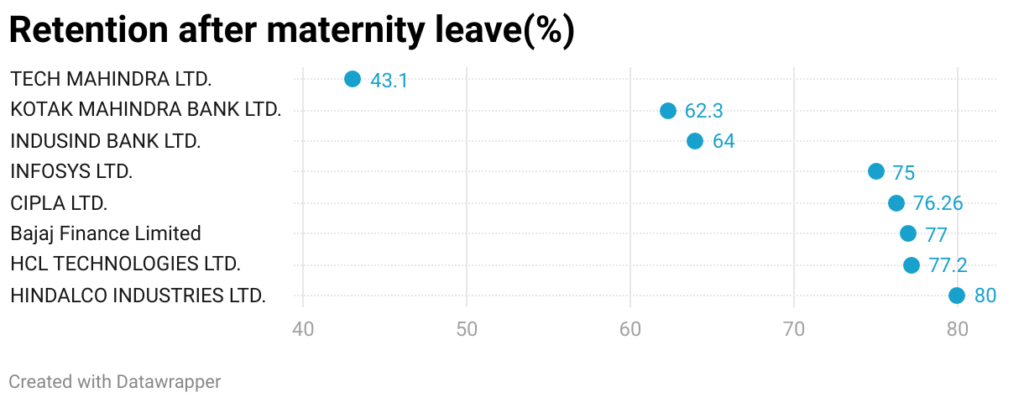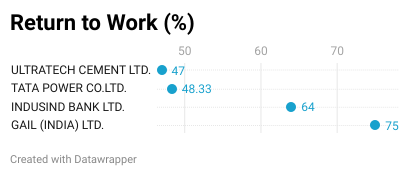Neethi Lisa Rojan | October 21, 2022
More than 80% of working women in India do not come under the purview of the Maternity Benefits Act
All women returned to work post-childbirth in 56 per cent of the 44 companies who publish Business Responsibility and Sustainability Reports (BRSR), according to information disclosed in their 2021-22 Annual Reports. Companies have adopted international practices in an attempt to ensure that maternity does not derail the career of women employees.
Data compiled by The Bottomline reveals that in a fifth of these companies, the percentage of women going back to work ranges from 90 to 99. All women remain in the job for over two years after childbirth in over 58 per cent of the companies analysed. While these numbers may reflect a positive picture, it must be remembered that women in formal employment are less than 1 percent of the Indian population.
Of the top 100 companies by market capitalisation, only 44 published Business Responsibility and Sustainability Reports (BRSR) as part of their Annual Reports for 2021-22. They include information on parental leave for employees and rejoining patterns. Publication of the report is voluntary for this period.
The Labour Force Participation Rate statistics for India for April-June 2022 showed that only 20.9 per cent were women. This is the lowest among South Asian nations, according to World Bank statistics. As per International Labour Organisation (ILO) 81.8 per cent of women in India work in the informal economy and do not enjoy any maternity benefits.
In recent years, multinational companies in India have taken several initiatives to support women in the formal sector during pregnancy and childbirth. This includes giving them online skill development sessions and sabbaticals, part-time or flexible work schedules, setting up sisterhood groups, or providing “buddy mothers” who assist new mothers in managing stress and anxiety. Indian companies quickly adopted them and have added other services such as providing expectant mothers with job-secured unpaid maternity leave after the mandatory maternity leave, structured reintegration programs to rejoin the workforce, gender sensitivity training for managers and regular conversations with managers about career management for working mothers.

“Indian companies have been able to create a more inclusive space in recent years,” according to Suraj Jadhav, Senior Research Analyst from Great Places to Work. He said this is partly because these top companies want to be on a par with Western standards.
India had taken a significant step for female employees with the Maternity Benefits Act, 2017. It increased the period of paid maternity leave that a woman employee is entitled to was increased to 26 weeks from 12. In fact, in this matter, India comes close to Scandinavian nations, best known for their healthcare and maternity benefits, according to ILO statistics. The Act even included leave of – six weeks and higher for women suffering miscarriages or adopting mothers.
“There are very few companies performing badly, which gives us an option to target them specifically and work towards a policy change,” said Rama Bijarpurkar, author and independent director on several Indian blue-chip boards.

“Women in the informal sector are helped by large families or elder children who help to raise the child, unlike the formal sector working women,” said Dr. Bhavani Rao, Head of Asia’s only UNESCO Chair on Gender Equality and Women’s Empowerment. “Women in the informal sector are helped by large families or elder children who help to raise the child, unlike the formal sector working women,” said Dr. Bhavani Rao, Head of Asia’s only UNESCO Chair on Gender Equality and Women’s Empowerment.
However, she added that it is not ideal to compare all companies using a blanket methodology to evaluate their employee welfare.
“A mix of economic, cultural, and societal factors comes into play here. Society gives more importance to a child’s human rights than a woman’s individual rights to leave her child and pursue a career,” Dr. Rao added.
Communications to the companies with low rejoining rates, enquiring reasons for such low numbers and mitigation strategies adopted by them remain unanswered.All the experts mentioned in the article have noted that Indian companies have indeed improved in treating women employees during maternity. However, all agree that there is a long road ahead to be covered to ensure all women in the formal sector return to work post-childbirth as there are a few companies.

